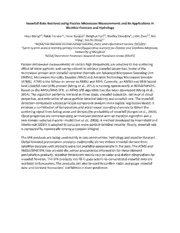
NASA Technical Reports Server (NTRS) 20150002901: Snowfall Rate Retrieval Using Passive Microwave Measurements and Its Applications in Weather Forecast and Hydrology PDF
Preview NASA Technical Reports Server (NTRS) 20150002901: Snowfall Rate Retrieval Using Passive Microwave Measurements and Its Applications in Weather Forecast and Hydrology
Snowfall Rate Retrieval using Passive Microwave Measurements and Its Applications in Weather Forecast and Hydrology Huan Meng1,2, Ralph Ferraro1,2, Cezar Kongoli2, Banghua Yan1,2, Bradley Zavodsky3, Limin Zhao1,2, Jun Dong2, Nai‐Yu Wang1,2 1NOAA/The National Environmental Satellite, Data, and Information Service (NESDIS) 2Earth System Science Interdisciplinary Center/Cooperative Institute for Climate and Satellites‐Maryland, University of Maryland 3NASA/Short‐term Prediction Research and Transition Center (SPoRT) Passive microwave measurements at certain high frequencies are sensitive to the scattering effect of snow particles and can be utilized to retrieve snowfall properties. Some of the microwave sensors with snowfall sensitive channels are Advanced Microwave Sounding Unit (AMSU), Microwave Humidity Sounder (MHS) and Advance Technology Microwave Sounder (ATMS). ATMS is the follow‐on sensor to AMSU and MHS. Currently, an AMSU and MHS based land snowfall rate (SFR) product (Meng et al., 2012) is running operationally at NOAA/NESDIS. Based on the AMSU/MHS SFR, an ATMS SFR algorithm has also been developed (Meng et al., 2014). The algorithm performs retrieval in three steps: snowfall detection, retrieval of cloud properties, and estimation of snow particle terminal velocity and snowfall rate. The snowfall detection component utilizes principal component analysis and a logistic regression model. It employs a combination of temperature and water vapor sounding channels to detect the scattering signal from falling snow and derives the probability of snowfall (Kongoli et al., 2014). Cloud properties are retrieved using an inversion method with an iteration algorithm and a two‐stream radiative transfer model (Yan et al., 2008). A method developed by Heymsfield and Westbrook (2010) is adopted to calculate snow particle terminal velocity. Finally, snowfall rate is computed by numerically solving a complex integral. The SFR products are being used mainly in two communities: hydrology and weather forecast. Global blended precipitation products traditionally do not include snowfall derived from satellites because such products were not available operationally in the past. The ATMS and AMSU/MHS SFR now provide the winter precipitation information for these blended precipitation products. Weather forecasters mainly rely on radar and station observations for snowfall forecast. The SFR products can fill in gaps where no conventional snowfall data are available to forecasters. The products can also be used to confirm radar and gauge snowfall data and increase forecasters’ confidence in their prediction.
